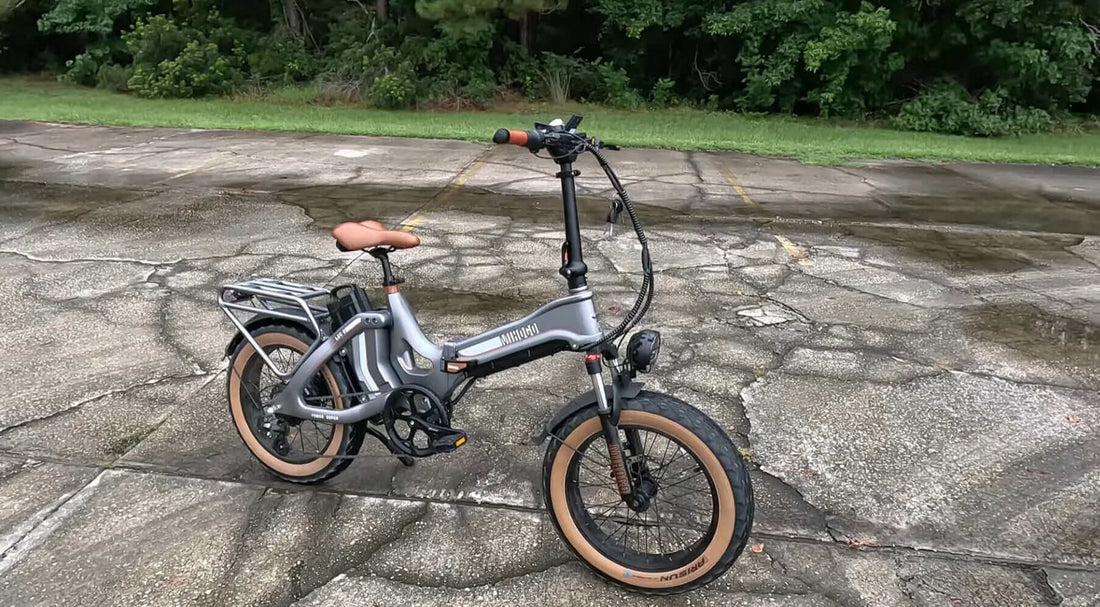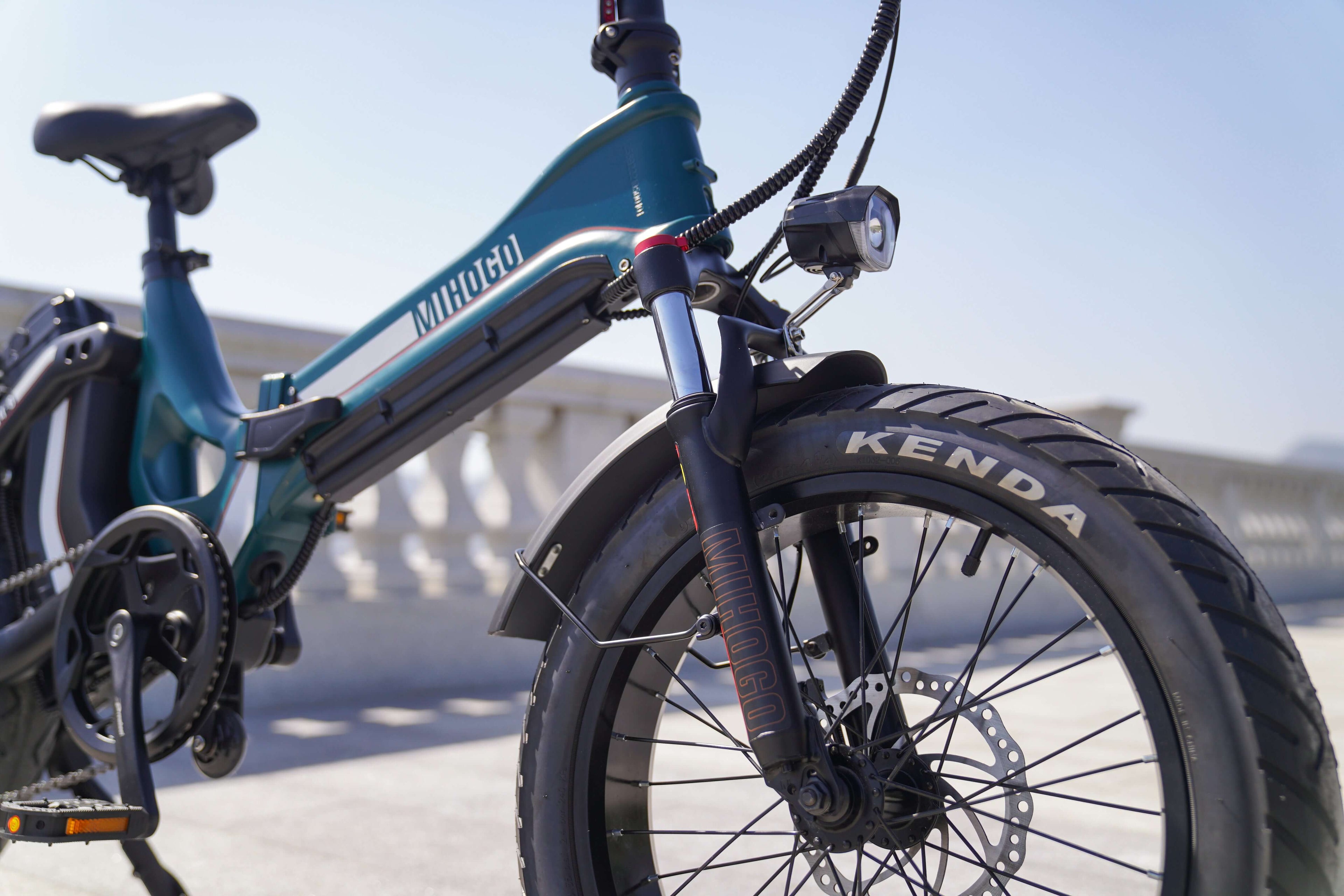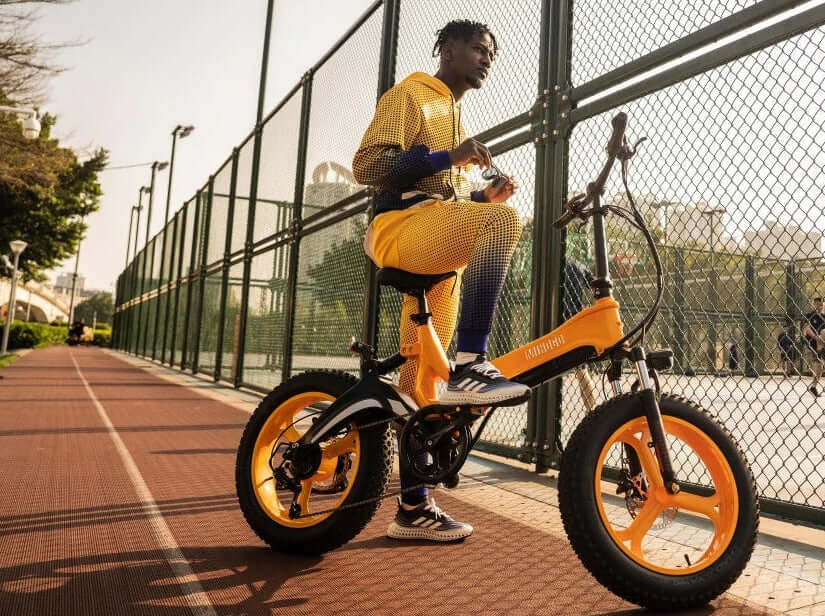Understanding Fat Tire Electric Bikes
Fat tire electric bikes, also known as fat e-bikes, are electric bicycles that feature wider tires, typically 4 inches or more in width. These bikes are designed for off-road terrain, providing increased stability and traction on loose or soft surfaces. The wider tires also make them more comfortable to ride on rough or uneven terrain.
Key Characteristics of Fat Tire E-bikes:
Tire Width: 4+ inches for maximum surface contact
Terrain Capability: Excels on sand, snow, mud, and rocky trails
Stability: Enhanced balance and confidence-inspiring ride
Comfort: Natural shock absorption from larger tire volume
Weight: Generally heavier due to robust construction
The Mihogo NX exemplifies premium fat tire engineering with its robust 20x4" tires. With the Mihogo NX, no terrain is too challenging. Its robust 20x4" tires are engineered to navigate sand, snow, and the most rigorous trails with ease. The model features dual suspension and can accommodate riders up to 500 pounds, making it perfect for European cyclists seeking versatility.
Standard Tire Electric Bikes: The Urban Champion
Traditional electric bikes typically have tires that are 2 inches or less in width, while fat tire electric bikes have tires that are 4 inches or more in width. This makes fat tire electric bikes more suitable for off-road terrain and more capable of handling rough or uneven surfaces.
Standard Tire E-bike Advantages:
Efficiency: Lower rolling resistance for better range
Speed: Optimized for pavement and smooth surfaces
Weight: Lighter construction for easier handling
Agility: Quick maneuverability in urban environments
Cost: Generally more affordable
Mihogo's Air Max and Mini models represent excellent standard tire options, designed specifically for European city commuting and recreational riding.
Performance Comparison: Fat vs Standard Tires
Range and Battery Life
The battery life of a fat tire electric bike will depend on the specific model and its components. Generally speaking, fat tire electric bikes have larger batteries than traditional electric bikes, which allows for longer rides between charges. However, the increased rolling resistance of fat tires can reduce overall efficiency.
Fat Tire Range: Many high-end fat tire electric bikes can last for up to 50 miles (80 km) on a single charge, but some can go even further. For instance, the Mihogo LX, with its dual 48V 28.8Ah battery system packing 1.4kWh of energy, lasts for up to 86 miles (138km) per charge.
Standard Tire Range: Typically achieves 15-25% better efficiency due to reduced rolling resistance, extending range on similar battery capacity.
Speed and Acceleration
The maximum speed of a fat tire electric bike will depend on the specific model and its components. Many fat tire electric bikes can reach speeds of up to 20 miles per hour (32 km/h) on flat terrain. Some models may have higher top speeds… for instance, our fat tire e-bikes have a top speed of 22 miles per hour (35km/h).
Standard tire e-bikes generally offer:
- Faster acceleration on paved surfaces
- Better maintained speeds on hills
- More responsive handling in traffic
Terrain Versatility
Fat Tires Excel At:
- Beach sand and snow riding
- Rocky mountain trails
- Muddy forest paths
- Gravel roads and bike paths
Standard Tires Excel At:
- City streets and bike lanes
- Paved cycling paths
- Indoor storage (lighter weight)
- Daily commuting efficiency
European Market Trends 2025
City dwellers are increasingly gravitating toward lightweight, foldable, and connected e-bikes that integrate with smartphone apps for navigation, anti-theft tracking, and performance analytics. This trend particularly favors versatile models that can adapt to both urban commuting and weekend adventures.
The European preference for folding e-bikes has influenced Mihogo's design philosophy. Folding e-bikes are all the rage in Europe, where space comes at a premium, and many commuters rely on public transit for at least a portion of their daily round-trip to and from the office.
Government Incentives and Infrastructure
European governments continue investing heavily in cycling infrastructure. Austria's Federal Ministry for Climate Protection, Environment, Energy, Mobility, Innovation and Technology is extending financial support until the end of February 2025. This aid is aimed at the purchase and operational use of electric bicycles, electric cargo bikes, cargo bikes, and electric folding bikes that are powered exclusively by electricity from renewable sources.
Mihogo's Solution: Best of Both Worlds
The Mihogo ONE Utility E-bike
With a staggering 85 Newton-meters of torque, it propels you forward with unmatched strength, making every journey an exciting adventure. Introducing the High-Security Electric Bike Steel Belted Puncture-Proof Tire, engineered to thrive on any terrain encountered by e-bikes.
Key Features:
- Dual battery system for extended range
- IPX5 water resistance for European weather
- Carbon fiber construction for lightweight durability
- Versatile tire design suitable for mixed terrain
Model Comparison
| Model | Tire Type | Best For | Range | Top Speed |
|---|---|---|---|---|
| Mihogo NX | Fat (20x4") | Off-road adventures | 80+ miles | 22 mph |
| Mihogo ONE | Utility/Hybrid | All-terrain versatility | 128 miles (dual battery) | 28 mph |
| Mihogo Air Max | Standard | Urban commuting | 60+ miles | 25 mph |
| Mihogo Mini | Standard | City mobility | 45+ miles | 20 mph |
Making the Right Choice for Your Needs
Choose Fat Tires If You:
- Plan regular off-road adventures
- Ride in snowy or sandy conditions
- Prioritize comfort over efficiency
- Want maximum stability and confidence
- Enjoy weekend trail exploration
Choose Standard Tires If You:
- Primarily commute on paved roads
- Value efficiency and range
- Need a lighter, more agile bike
- Have limited storage space
- Focus on urban mobility
Safety and Maintenance Considerations
Fat tire electric bikes are usually safe for off-roading. These bikes are specifically designed to handle various terrains, including rough and uneven tracks, thanks to their large, wide tires that provide stability and grip.
Maintenance Tips:
- Check tire pressure regularly (fat tires run at lower PSI)
- Clean and lubricate drivetrain components
- Monitor brake performance, especially after wet rides
- Store battery properly during European winters
The Future of European E-biking
2025 is the year eBikes become truly "smart." Here are the top innovations shaping the industry: AI algorithms that adjust motor output based on terrain, rider weight, and riding style. Mihogo continues to integrate these cutting-edge technologies across both fat tire and standard tire models.
Emerging Trends:
- Smart connectivity and app integration
- Improved battery technology for extended range
- Enhanced motor efficiency for all tire types
- Sustainable manufacturing practices
Conclusion
The choice between fat tire and standard tire e-bikes ultimately depends on your riding priorities and European lifestyle. Fat tires offer unmatched versatility and comfort for mixed-terrain adventures, while standard tires provide optimal efficiency for urban commuting.
Mihogo's diverse lineup ensures there's a perfect electric bike for every European rider. Whether you choose the adventure-ready NX with fat tires or the efficient Air Max with standard tires, you're investing in premium quality, innovative design, and the freedom to explore Europe's diverse landscapes.






